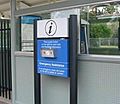Railways in Melbourne facts for kids
Quick facts for kids Melbourne railway network |
|
|---|---|
 Old Flinders Street Station.jpg |
|
| Info | |
| Owner | VicTrack |
| Locale | Melbourne, Victoria Australia |
| Transit type | Commuter rail |
| Number of lines | 16 |
| Number of stations | 220 |
| Operation | |
| Began operation | 12 September 1854 |
| Operator(s) | Metro Trains Melbourne V/Line |
| Number of vehicles | 224 six-car sets (October 2018) |
| Technical | |
| System length | 405 km (252 mi) |
| Track gauge | 1,600 mm (5 ft 3 in) Victorian broad gauge |
| Old gauge | Various |
| Electrification | 1500 V DC overhead (excluding Stony Point, which is not electrified) |
Melbourne has a long history of railway building. The city's first railway opened in 1854. This was even before Melbourne itself was officially founded in 1834! The train network grew a lot as new lines were built across the suburbs. It reached its biggest size by the 1900s. Electric trains started running in 1919.
Contents
Melbourne's Train Network
Melbourne's train network is a big part of how people get around the city. It helps millions of people travel every year. The network has many lines and stations.
How Many Lines and Stations?
The Melbourne railway network has 16 different train lines. These lines connect to 220 train stations. This makes it easy for people to travel to many parts of Melbourne.
Who Runs the Trains?
The main operator for the suburban trains is Metro Trains Melbourne. Another company, V/Line, also uses some of the tracks for longer trips.
Types of Trains You Might See
Over the years, many different types of trains have been used in Melbourne.
- Steam Trains: In the early days, trains were pulled by steam engines.
- Electric Trains: From 1919, electric trains started to be used. These trains get their power from overhead lines.
- Modern Trains: Today, you'll see modern electric trains like the Comeng, Siemens, and X'Trapolis models. There are also newer HCMT trains.
Old Train Models
Some older train models were very important in Melbourne's history.
- Tait Trains: These were some of the first electric trains. They were sometimes called 'Red Rattlers'.
- Harris Trains: These trains were used for many years before being retired.
How the Network Works
The railway network uses different types of tracks.
- At-grade: This means the tracks are on the ground level.
- Elevated: Some tracks are built above the ground, like on bridges or viaducts. This helps trains go over roads or other obstacles.
- Underground: Parts of the network, like the City Loop, go underground. This helps trains travel through the city centre.
Train Power and Tracks
Most of Melbourne's trains are electric. They get their power from 1500 Volt DC overhead wires. The tracks have a special width called a 'gauge'. Melbourne uses a 'Victorian broad gauge'.
Busy Network
The Melbourne train network is very busy. In 2017-2018, over 240 million trips were made on the trains! This shows how important the railway is for the city.
Images for kids
-
The pre 1910 Flinders Street railway station building on Swanston Street
-
Melbourne Central railway station in the underground City Loop
-
Quadruple track near Caulfield station, showing signalling and overhead wiring
-
Newer style colour LCD PID used on the platforms at Flinders Street Station
See also
 In Spanish: Connex Melbourne para niños
In Spanish: Connex Melbourne para niños



























